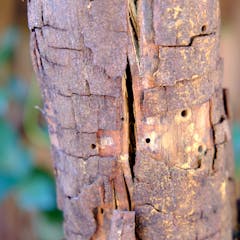
Artikel-artikel mengenai Invasive species
Menampilkan 1 - 20 dari 312 artikel

Water lettuce forms dense mats on the water surface. This can reduce light penetration and oxygen levels in the water, negatively affecting all aspects of aquatic life.

New research suggests if we can’t eradicate cane toads, we can teach wildlife not to eat them.

Bushwalkers with smartphones could help scientists track a fungus lethal to many of Australia’s most loved trees.

Tardigrades are tiny animals known for their extraordinary survival skills, but are they tough enough to survive a space-probe crash and conditions on the Moon?

We need every tool at our disposal to stop feral cats and foxes from decimating Australia’s incredible wildlife after fires. Artificial refuges show promise.

It’s a horror story unfolding in the west that could sweep across the country. Beware the shot-hole borer, an exotic pest that threatens our tree crops, plantations, urban forests and wild places.

Cane toads are evolving as they spread across Australia. Parasitic lungworms are becoming more infectious to keep up.

It’s hard work saving birds from extinction, but we have the evidence of successful interventions to show we can avoid further losses.

It wasn’t just colonists and convicts who invaded Australia in 1788 – invasive plant species arrived too.

There are hundreds of lost tetrapod species across the globe and their number are increasing decade-on-decade. This study aims to find out why some are rediscovered, while others are not.

Conservation dogs perform vital roles across Australia. Some are guardians protecting wildlife from predators while others put their powerful sense of smell to use as sniffer dogs or detection dogs.

Invasive species such as deer, pigs and rabbits might help boost native predator populations.

Grassfires are normal in central and northern Australia. But fast-growing invasive grasses are supercharging grassfires – and this summer looks like it will be big.

When ships sink, they add artificial structures to the seafloor that can quickly become diverse, ecologically important underwater communities.

Feral hogs are one of the most destructive invasive species in North America, harming land, crops and wildlife.

Non-native species tend to be better at exploiting the disturbance caused by storms, fires or droughts.

Controlling invasive sea urchins is expensive. Why not make it profitable by fishing for them and selling their roe as a delicacy?

More than half of the world’s turtle species are endangered or threatened, and overhunting of wild species is a major cause.

The Peach Blossom Jellyfish is an invasive species in Canada, and a lack of data is hampering efforts to control populations.

The new report on alien invasive species doesn’t just concentrate on problems. It also offers solutions.
